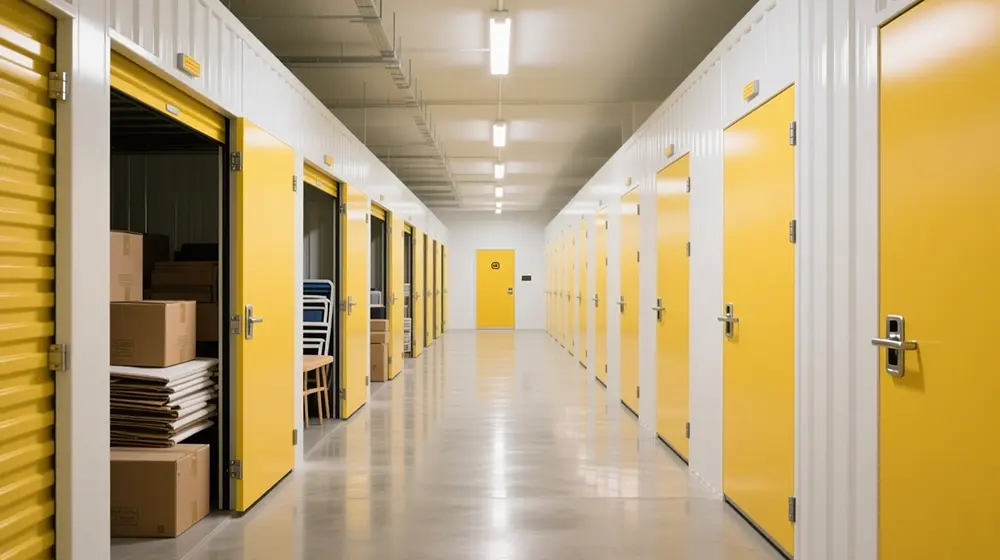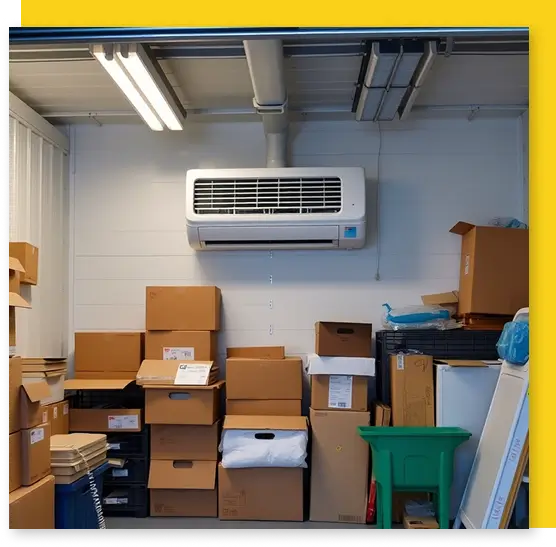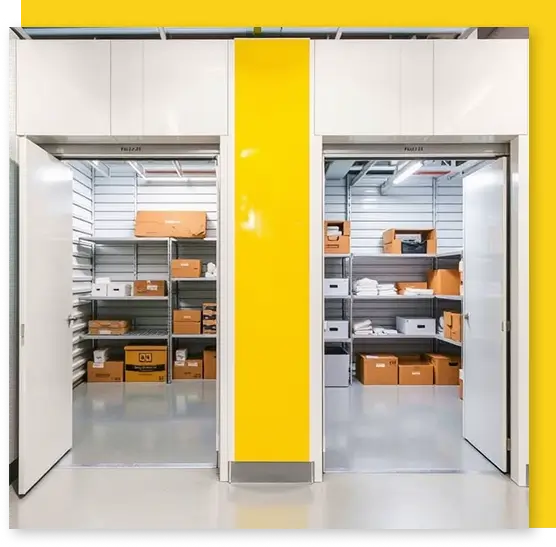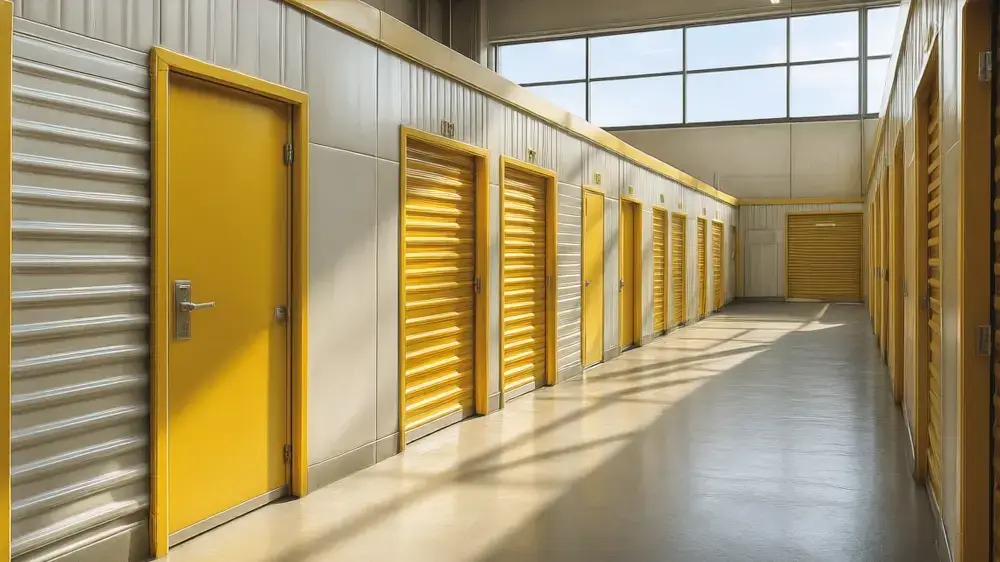Downsizing in Dubai reduces floor area and built-in storage, so smart storage solutions become the operating system of a smaller home. Smaller homes shift how you store, rotate, and protect belongings in a hot, humid coastal climate. The right storage plan prevents constant clutter and re-purchasing.
The UAE self-storage market generated a revenue of USD 602.5 million in 2024 and is expected to reach USD 859.2 million by 2030. This is evidence that storage is now a mainstream tool for right-sizing space.
Climate is the second constraint. Coastal humidity in Dubai often sits in the 50% and 60% band during peak periods, so climate-controlled storage in Dubai protects electronics, wood, leather, and documents while you compress the footprint at home.
This guide highlights:
- Rent-gap vs storage comparisons you can action today.
- Storage sizes and typical costs (25–50 sq ft) for budgeting.
- Room-by-room tactics for compact living in Dubai’s heat and humidity.

Why does downsizing in Dubai require smart storage planning?
Smart storage planning preserves liveable space, reduces rent-driven pressure, and fits the climate. A smaller home in Dubai works when every cubic metre has a clear role. Storage choices also reduce stress linked to visual clutter.
- Rent economics: Typical studio vs 1-bed rent gaps are material, so staying compact and adding storage can be cheaper than upsizing.
- Human factors: Research links cluttered home descriptions with higher daily cortisol; visual clutter also competes for attention. Storage discipline lowers cognitive load.
What unit sizes define “smaller homes” in Dubai?
Dubai studios and one-bedrooms commonly fall into compact ranges. These sizes guide the storage mix (built-in, modular, off-site).
Typical ranges (apartments):
- Studio: ~450–600 sq ft
- 1-Bedroom: ~700–900 sq ft
- 2-Bedroom: ~1,100–1,400 sq ft
Implication for storage: Minimal utility rooms and limited wardrobes push you toward vertical storage, under-furniture capacity, and category zoning in small footprints.
How does Dubai’s climate change storage choices?
Dubai’s heat and seasonal humidity accelerate mold, warping, and adhesive failure. Storage for textiles, wood, leather, and electronics needs climate awareness. Smart storage in Dubai prioritizes climate-controlled environments for vulnerable categories.
- Humidity reality: Coastal UAE humidity frequently ranges ~70–90% at night during muggy periods; NCM warns of fog/mist when humidity spikes. Climate control protects sensitive items.
- Cooling add-ons: Some buildings bill district cooling separately (e.g., AED 0.568/RT-hour consumption + AED 750/RT-year demand). This cost is independent of DEWA electricity. Verify if the unit is chiller-free.
- Official authority: The UAE National Center of Meteorology (NCM) provides the country’s humidity and weather data feeds used by media and public advisories.
- Decision rule: If your rent gap ≥ storage fee + expected cooling premium, downsizing still pays.
Which smart storage solutions work best when downsizing in Dubai?
Each solution below starts with a direct benefit, then shows exact moves. Use multiple solutions in layers to maximize a smaller home.
Multifunctional, built-in furniture for compact living in Dubai
Multifunctional pieces reclaim hidden volume and remove the need for extra casework. In smaller Dubai apartments, this change unlocks daily comfort.
Do first:
- Drawer bed bases (4–6 deep drawers).
- Lift-top coffee tables with concealed bins.
- Storage ottomans; bench seating with hinged lids.
- Wall-to-wall wardrobes built to full 2.7–3.0 m height (common ceiling range).
Capacity hint: Drawer bed + ottoman + full-height wardrobe easily adds 400–800 L storage per bedroom (model-dependent).
Tip: Prefer full-extension runners and 90–110° hinges for complete access in tight rooms.

Vertical and wall-mounted storage to free floor space
Vertical storage converts walls and doors into organized capacity. Floor remains free for movement, which matters in studios and 1-beds.
- Mount these: Floating shelves, rail systems, pegboards, behind-door racks, and wall ladders for blankets.
- Ceiling usage: Overhead bike hoists or ceiling racks for suitcases.
- Ergonomics: Keep the top shelf ≤45 cm from the ceiling to reach safely in 2.7 m rooms.
Under-furniture roll-outs for stealth capacity
Roll-outs exploit low-profile zones. You gain volume with minimal visual load.
- Use cases: Rolling bins under sofas, media units, kid beds; flat trays under dressers.
- Store here: Seasonal shoes, linens, travel kits, beach gear.
Modular, adjustable racking for small Dubai kitchens and store rooms
Modular racks adapt to shifting needs, rentals, and renovations. Adjustable shelves increase density vs fixed spans.
- Specs that work: 30–40 cm shelf depth for mixed bins; vertical pitch 3–5 cm.
- Where: Galley kitchens, pantries, store rooms, wardrobes.
- Outcome: Expect ~10–15% better packing density than fixed shelves of the same volume (like-for-like).
Climate-controlled self-storage in Dubai to avoid upsizing
Self-storage removes seldom-used volume from your living area. In Dubai, climate control protects materials from heat/humidity.
What to store: Luggage, archives, seasonal décor, sports gear, spare furniture, prams.
Typical price cues:
25 sq ft lockers: ~AED 300–400/month
50 sq ft rooms: ~AED 900–1,400/month
Larger rooms scale with amenities and location. Climate control costs more but protects value.
Alternative rates: Operators advertise entry-level storage from AED 149/month for small categories; 5 m² climate-controlled units around AED 400/month are also marketed in UAE zones. Validate features and location.

Seasonal rotation and disciplined decluttering for smaller homes
Rotation reduces visible volume and protects attention. Downsizing in Dubai works when off-season items leave living zones.
Cycle example:
- Nov–Mar: Keep beach gear handy; box winterwear.
- Apr–Oct: Reverse the set; move coats to off-site or top shelves.
Evidence: Cluttered home narratives correlate with elevated daily cortisol; visual clutter competes for neural representation and attention.
Rule: One-in/one-out for apparel and décor; quarterly 90-day usage test.
(7) Doors, corners, and under-stair voids as micro-storage zones
Dead zones become stable capacity with well-sized hardware. This protects traffic flow.
- Add: Over-door racks, corner floating shelves, slim rolling carts, pull-out trays for corner bases, under-stair cabinets in duplexes/townhouses.
- Yield: Under-stair areas can deliver ~2–3 m² enclosed storage in villas/townhouses, depending on geometry.
Transparent bins and hard labels to stop item loss
Clear visibility prevents duplicates and failed retrievals. Labels create quick wins in smaller homes.
- System: Same-size clear bins, front labels = room + category + date.
- Extras: QR labels linked to photo inventories for tech-savvy users.
- Result: Fewer re-buys; lower rummaging time.
Fold-down and fold-away furniture to multiply room functions
Foldables switch rooms between uses without a permanent footprint. This is essential in studios.
- Pieces to consider: Murphy beds; wall desks; drop-leaf tables; nesting side tables.
- Placement: Guest room/study combos; living rooms with ad-hoc workstations.
Category-based micro-zones to prevent sprawl
Micro-zones cap categories to defined shelves. Smaller homes stay organized when every category has a fixed bay.
- Create zones: “Mail + keys,” “Repairs,” “Travel,” “Pet care,” “Sports.”
- Constraint: Limit each zone to 1–2 shelves; use bins to enforce boundaries.
- Cueing: Color-consistent labels guide fast returns.
Balcony and store room strategy for Dubai apartments
Balconies and stores can help, but climate risk is real. Use only weather-proof setups.
- Do: Gasketed bins, desiccant packs, raised platforms.
- Don’t: Store electronics, fine papers, untreated wood outside in summer.
- Why: Night humidity and sea air corrode; use climate-controlled options for valuables.
Move-day sequencing for compact living in Dubai
Sequencing prevents overflow in a smaller home. Pack by zones, not by rooms, and stage off-site items early.
Plan:
- Measure alcoves, lift sizes, and door clearances.
- Order modular racks and bins first; assemble before move-in.
- Send low-use items to climate-controlled storage the week before handover.
- Unpack by category zones, not by cartons.
Cost-Driven Downsizing in Dubai: Rent vs Storage Math for Smaller Homes
Residents who can shift from a 1-bed to a studio and place overflow in self-storage achieve net monthly savings in most districts. Savings persist when storage is climate-controlled for sensitive items.
- Why it works: The rent gap between studio and 1-bed often exceeds the monthly fee for 25–50 sq ft storage.
- Market proof: Dubai asking rents stayed elevated in H1-2025, with area-by-area studio/1-bed differentials intact.
- Price anchors: 25 sq ft lockers typically AED 300–400/month; 50 sq ft units AED 900–1,400/month. Entry offers from AED 149 exist.

Which one-time costs affect a downsizing decision in Dubai?
Residents must include moving, Ejari, agency fee, and deposits. Quantifying them keeps the smaller home plan realistic.
- Movers (local): Studio AED 1,000–1,200; 1-bed AED 1,200–1,500.
- Ejari registration: AED 120–220 depending on channel.
- Agency commission (typical): 5% of annual rent or min ~AED 5,000 on low rents.
- DEWA / Cooling deposits: See DEWA calculator and provider rules; some cooling providers take separate deposits.
Cost comparison: Upsizing versus storage for downsizing in Dubai
Downsizing in Dubai cuts rent when the monthly rent gap between a 1-bed and a studio is larger than the self-storage fee + utilities add-ons. 2025 market data shows citywide averages where this condition often holds, especially with 25–50 sq ft units.
- Average studio rent (citywide): ~AED 36,000/yr; Average 1-bed: ~AED 56,000/yr → monthly rent gap ≈ AED 1,667.
- Self-storage Dubai: 25 sq ft = AED 300–400/month; 50 sq ft = AED 900–1,400/month; some entry promos from AED 149/month.
- 5 m² climate-controlled unit (UAE): AED 400–450/month (air-conditioned).
- District cooling (illustrative structure): Consumption ~0.56–0.568 fils/RT-hour + demand ~AED 750/RT-year (provider-specific). Use your provider’s schedule.
- DEWA: Progressive slab tariff + fuel surcharge; model your actual kWh/m³ in the Tariff Calculator.
Quick math you can apply today
Formula:
Net saving (per month) = Rent gap − Storage fee − Cooling (if any) − Other monthly expenses.
District rent gap vs. storage (monthly math)
| Area | Studio (AED/yr) | 1-bed (AED/yr) | Rent gap (AED/month) | Net w/ 25 sq ft (AED 300–400/month) | Net w/ 50 sq ft (AED 900–1,400/month) |
|---|---|---|---|---|---|
| Bur Dubai | 49,000 | 80,000 | 2,583 | 2,183–2,283 | 1,183–1,683 |
| Arjan | 52,000 | 77,000 | 2,083 | 1,683–1,783 | 683–1,183 |
| Deira | 34,000 | 73,000 | 3,250 | 2,850–2,950 | 1,850–2,350 |
| JVC | 55,000 | 78,000 | 1,917 | 1,517–1,617 | 517–1,017 |
| Business Bay | 77,000 | 110,000 | 2,750 | 2,350–2,450 | 1,350–1,850 |
| JLT | 66,000 | 96,000 | 2,500 | 2,100–2,200 | 1,100–1,600 |
Citywide anchors (use for fast budgeting)
| Item | Typical figure |
|---|---|
| Avg studio rent (Dubai) | AED 36,000/yr |
| Avg 1-bed rent (Dubai) | AED 56,000/yr |
| 25 sq ft storage (locker) | AED 300–400/month |
| 50 sq ft storage (room) | AED 900–1,400/month |
| 5 m² climate-controlled unit (UAE) | ~AED 400/month |
| District-cooling demand | AED 750 per RT/year |
| District-cooling consumption | ~0.56–0.568 fils/RT-hour |
Important Tip
- “Net saving” = (1-bed − studio)/12 − storage − cooling − other monthly.
- Cooling and DEWA vary by building/provider; plug actuals into your mode
If a household can adapt to a studio and add a 50 sq ft unit at AED 1,100/month (~AED 13,200/yr), total carrying cost may still undercut a 1-bed in some districts, especially with entry-level studio rents and negotiated storage rates. Validate by building, district, and facility features.
What storage size fits common downsizing scenarios in Dubai?
Residents can match net savings with capacity. The 25–50 sq ft range covers most studio/1-bed overflow.
- 25 sq ft (boxes, luggage, documents): AED 300–400/month.
- 50 sq ft (studio-size overflow): AED 900–1,400/month.
- Locker alternatives (15–30 sq ft): AED 250–375/month; useful for seasonal storage if the rent gap is small.

What’s the 3-step costing workflow for downsizing in Dubai?
A short, repeatable method reduces decision time and aligns with smart storage solutions.
- Measure your rent delta: Use district-level studio vs 1-bed rents. Compute (1-bed – studio)/12.
- Pick storage capacity: Start with 25 sq ft, upgrade to 50 sq ft only if items don’t compress. Use operator price ladders.
- Add utilities and fees: Include DEWA, cooling, Ejari, agency, and movers to get month-one and steady-state costs.
Room-by-room blueprint for smaller Dubai homes
Two short lines first to keep context tight. Use uniform containers, fixed shelf depths, and consistent labels across rooms.
- Entry (micro-mudroom): Slim shoe cabinet; wall hooks; umbrella tube; tray for mail and keys. Add a shallow bench with lift-lid storage.
- Living: Lift-top coffee table; media unit with drawers; picture-ledge shelves for remotes and chargers. Hide cable boxes in ventilated bins.
- Kitchen (galley focus): Rail systems for utensils; door-back spice trays; 30–40 cm deep shelves for mixed bins; lazy Susans for corners; tall slot for trays.
- Bedroom: Full-height wardrobes; drawer bed; vacuum bags for linens; shelf pitch ~25–30 cm for apparel; top shelf for off-season boxes.
- Bathroom: Over-toilet shelf; magnetic strips for grooming tools; caddies; sealed bins for humidity.
- Store room: Adjustable racks; clear bins; A-to-Z labeling by category; desiccants for paper.
- Balcony (cautious): Weather-proof bins only; avoid electronics and papers in summer humidity spikes.
- Off-site unit: Archive boxes; seasonal décor; sports gear; prams; spare furniture. Seek 24/7 access and climate control as needed.
Mistakes to avoid when downsizing in Dubai
Downsizing in Dubai punishes storage mistakes. Small errors raise costs and shrink usable volume in a smaller home. Use smart storage solutions that account for Dubai humidity and choose climate-controlled storage for sensitive items.
- Buying storage before measuring elevators, doors, and alcoves.
- Ignoring humidity, store sensitive items in climate-controlled conditions.
- Mixing container sizes; inconsistent bins waste cubic volume.
- Skipping labels; retrieval time and duplicates surge.
- Keeping “just in case” items, use a 90-day rule.
- Over-linking rooms; keep micro-zones tight and near point-of-use.
- Overpaying for bigger rent instead of right-sizing storage; compare numbers.
- Storing high-value wood/leather on balconies; heat and humidity will damage finishes.
Conclusion: Close the Space–Cost Gap in Dubai with Climate-Smart Storage
Downsizing in Dubai works when rent gaps exceed storage fees and when humidity risk is managed. Climate-controlled storage protects electronics, leather, wood, and documents during high-RH nights. A smaller home stays functional with a single context plan: measure the rent delta, pick a 25 or 50 sq ft capacity, and model cooling + DEWA against savings. Entry offers from AED 149 exist; 5 m² AC units around AED 400–450 also operate in the UAE. Use climate-controlled facilities for sensitive items.
Key takeaways
- Compute (1-bed – studio) ÷ 12 and compare to storage fees.
- Use 25 sq ft = AED 300–400/month; 50 sq ft = AED 900–1,400/month as budgeting anchors.
- Track humidity advisories; 70–90% night RH appears in forecasts and drives fog/mist risk. Prioritize climate control.
- Verify district cooling line items: 0.568 fils/RT-hour (consumption) and AED 750/RT-year (demand) appear in public guides.
FAQs: Downsizing in Dubai — Cost and Storage
Is downsizing plus storage cheaper than keeping a 1-bed?
Yes, when the monthly rent gap exceeds a 25–50 sq ft storage fee. Area data in H1-2025 support this outcome across multiple districts.
What storage size fits most smaller homes?
25 sq ft covers boxes, luggage, papers. 50 sq ft holds low-use furniture and gear. Pricing bands: AED 300–400 and AED 900–1,400 per month.
Does Dubai’s humidity justify climate-controlled storage?
Yes. Night humidity often reaches ~70–90% on coastal corridors and triggers fog/mist advisories; sensitive materials degrade faster without control.
Where can I check current rent levels by area?
Use Bayut’s H1-2025 Rental Market Report for studio and 1-bed averages by district.
How do district-cooling charges affect savings?
Model 0.568 fils/RT-hour (consumption) plus AED 750/RT-year (demand) against the rent gap. Net savings often remain positive when gaps are large.
Where can I confirm DEWA billing inputs?
Use DEWA’s Tariff Calculator and Slab Tariff pages to estimate slabs and fuel surcharge; VAT 5% applies to consumption.
What evidence links clutter to stress in smaller homes?
Peer-reviewed work shows links between cluttered-home language and flatter diurnal cortisol slopes; visual competition research explains attention drain.


